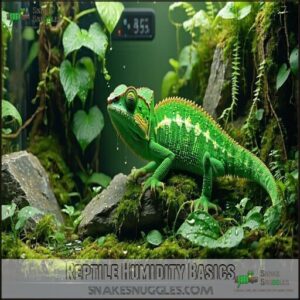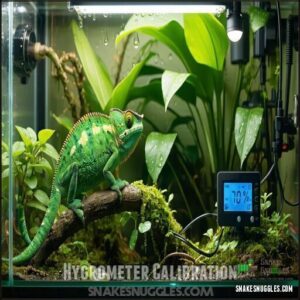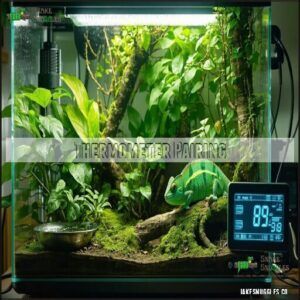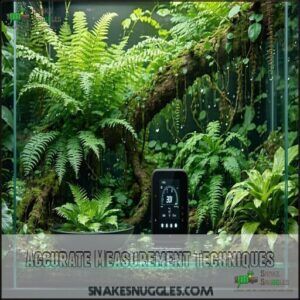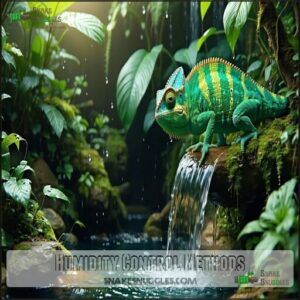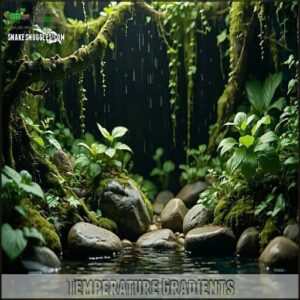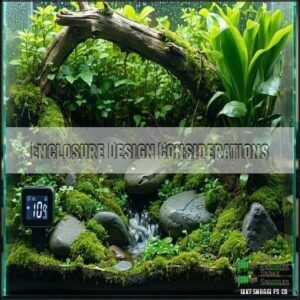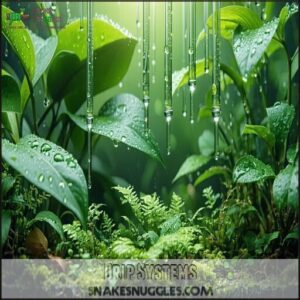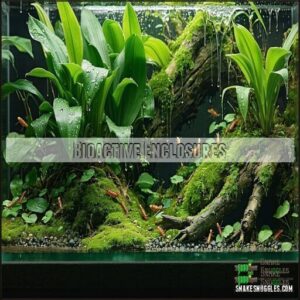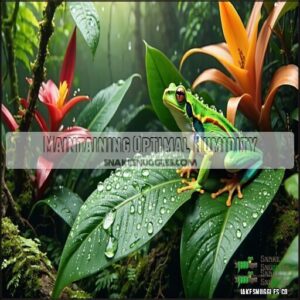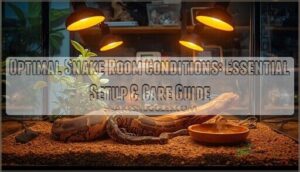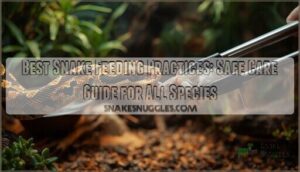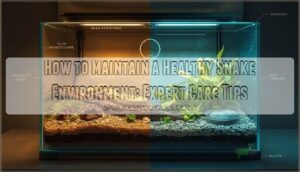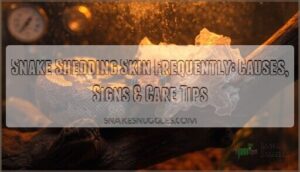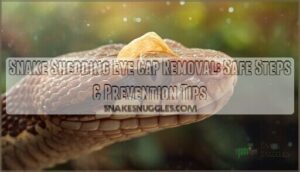This site is supported by our readers. We may earn a commission, at no cost to you, if you purchase through links.
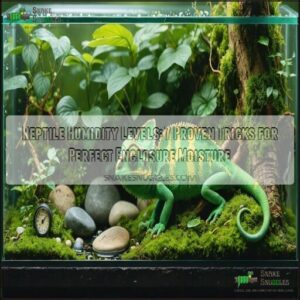
Use a reliable hygrometer to check levels daily—guessing won’t cut it.
If humidity’s too low, your reptile might struggle with shedding or even breathing issues. To boost moisture, try misting, adding a water bowl, or using a damp substrate.
Too much humidity, though, can encourage mold and bacteria.
Remember, every species has unique needs, so research is key. Curious about easy tricks to fine-tune their enclosure? A few smart tweaks can make all the difference.
Table Of Contents
- Key Takeaways
- Reptile Humidity Basics
- Humidity Measurement Tools
- Humidity Control Methods
- Temperature Gradients
- Enclosure Design Considerations
- Humidity Enhancement Techniques
- Maintaining Optimal Humidity
- Frequently Asked Questions (FAQs)
- Why is humidity important in reptile enclosures?
- What is good humidity for a reptile?
- How to keep humidity high in a reptile tank?
- Can high humidity cause respiratory problems in reptiles?
- Do reptiles have different humidity preferences?
- Why do Reptiles need humid and warm conditions?
- What should the humidity be for reptiles?
- Is 70% humidity too high for ball python?
- Is 60% humidity too high for bearded dragons?
- Is 70% humidity too high for a leopard gecko?
- Conclusion
Key Takeaways
- Use a reliable hygrometer to check humidity daily and ensure it is accurate; guessing will not work.
- Match humidity levels to your reptile’s species—desert reptiles need around 30-40%, while tropical species thrive in 70-90%.
- Boost humidity with misting, water bowls, or damp substrates, but do not overdo it or you will risk mold and bacteria growth.
- Balance humidity with proper ventilation—too much moisture can cause respiratory issues, while too little affects shedding and hydration.
Reptile Humidity Basics
Maintaining proper humidity levels in your reptile’s enclosure is essential for their health, just as you need the right amount of moisture in your own home.
Proper humidity keeps your reptile healthy—supporting shedding, respiratory function, and hydration just like moisture balance benefits your own environment.
You’ll need to match the humidity level to your specific reptile species.
Desert dwellers needing 30-40% moisture while tropical species require 70-90% for proper shedding and respiratory function.
Ideal Humidity Range
Finding the ideal reptile humidity range is key to your pet’s health. Most reptiles thrive between 40-60% relative humidity, though ideal levels vary.
Here’s what proper humidity affects:
- Successful shedding cycles
- Respiratory health
- Proper hydration
- Disease prevention
Measuring humidity regularly with a reliable hygrometer helps maintain these perfect reptile humidity levels and prevents potentially serious health complications. Successful shedding cycles are also dependent on proper humidity.
Species-Specific Humidity Needs
Your reptile’s humidity needs depend entirely on its natural habitat. Desert species like leopard geckos thrive at 30-40% humidity, while tropical reptiles such as crested geckos need 60-80% humidity.
Temperate species fall somewhere in between.
For snakes, species-specific humidity is essential.
Remember, individual variation exists even within species – some ball pythons might prefer slightly higher humidity than others. Always research your specific pet’s requirements rather than following general guidelines. Species-specific humidity is crucial for their well-being. Individual variation exists, so avoid generalizations. Provide proper humidity levels for your reptile’s health.
Importance of Hygrometers
A good hygrometer is the foundation of proper reptile care. You can’t manage what you don’t measure accurately.
A reliable hygrometer ensures your reptile thrives—measure humidity right to prevent health issues and keep shedding cycles smooth.
Digital hygrometers typically offer better accuracy than analog versions when monitoring reptile humidity levels.
Place your humidity gauge away from water dishes and misting areas for true readings. Check readings regularly and calibrate your hygrometer according to manufacturer instructions to maintain ideal humidity levels for your pet.
Humidity Measurement Tools
You’ll need reliable tools to measure humidity levels in your reptile’s home. Hygrometers are essential equipment for any serious keeper.
These devices display the current moisture percentage in your enclosure. This helps you make quick adjustments before small problems become serious health issues for your scaly friend.
Hygrometer Calibration
Now that you understand why monitoring humidity matters, let’s make sure your readings are accurate. Your hygrometer won’t help much if it’s giving false information. Proper snake tank humidity levels are vital for reptile health.
- That sinking feeling when you realize your reptile’s health issues were caused by an uncalibrated hygrometer
- The peace of mind from knowing your readings are accurate
- The frustration of constantly adjusting based on incorrect measurements
- The satisfaction of mastering proper calibration techniques
- The confidence in providing the best care for your scaly friend
Calibrate digital hygrometers every 3-6 months for reliability. Most units include verification instructions using salt tests or calibration solutions.
Analog hygrometers typically require manual adjustment. Regular accuracy verification guarantees your humidity gauge provides trustworthy relative humidity measurements.
Thermometer Pairing
Now that your hygrometer is calibrated, pair it with a thermometer for complete environmental monitoring. Many devices combine readings of both temperature and humidity levels in one unit.
You can buy a reptile thermometer hygrometer online.
When placing your thermometer-hygrometer combo, consider different spots in your enclosure to track gradients. Digital advancements have made data logging easier, so you can track reptile humidity patterns over time. Some units even sync after calibration for more accurate measurements.
Accurate Measurement Techniques
Your hygrometer’s position makes all the difference in getting accurate readings. Place digital hygrometers at mid-level in your enclosure—not too close to water features or heat sources.
Take measurements at different times daily to track humidity fluctuations.
You can purchase a reptile hygrometer online.
Calibrate your humidity sensor monthly using the salt test method.
For larger enclosures, consider using multiple monitors to map moisture gradients across the habitat.
Humidity Control Methods
You’ll need reliable ways to control moisture in your reptile’s home to prevent health issues like shedding problems or respiratory infections.
From automated misting systems to strategic water bowl placement, these methods will help you maintain the perfect humidity level for your scaly friend.
Misting Systems
For consistent moisture control, misting systems offer an effective solution for your reptile’s humidity needs. These automated devices deliver precise water droplets throughout the enclosure. You can find a variety of reptile misting system products online.
You’ll find both simple mister bottles for manual use and sophisticated automatic misting systems with programmable timers.
- Nozzle types impact droplet size and coverage area
- Pump frequency determines how often misting occurs
- Reservoir size affects how long between refills
- Tubing placement guarantees even moisture distribution
Foggers
While misting systems spray water droplets, foggers offer a gentler approach to increasing reptile humidity levels.
Maintaining proper humidity levels is crucial for reptile health.
Foggers create a fine mist that blankets your entire enclosure, potentially boosting humidity by up to 100%.
With reservoir sizes up to 2.5 liters, you’ll enjoy longer periods between refills.
Remember to check tubing regularly for bacterial buildup to maintain healthy reptile humidity control.
Proper nozzle placement guarantees even fog distribution throughout the habitat.
Substrate Selection
Beneath your reptile’s feet lies the key to perfect humidity control. Your substrate choice directly impacts moisture levels in the enclosure.
- Cypress mulch and eco earth trap moisture effectively, ideal for tropical species needing higher humidity
- Sphagnum moss acts like a natural humidity sponge, releasing moisture slowly over time
- Desert reptiles benefit from sand mixtures that provide low moisture retention and prevent mold
Choose materials that match your pet’s burrowing needs and natural habitat.
Water Bowl Placement
Three strategic water bowl placements can dramatically impact your reptile’s humidity levels.
Position the bowl on the warm side of the enclosure to increase evaporation rates. This creates a natural humidity gradient throughout the reptile enclosure.
For even better results, try slightly heating the water to boost moisture levels.
Precise moisture control is vital, so consider optimal snake terrarium humidity. Just make certain the bowl remains accessible for drinking while supporting proper humidity control. Increase evaporation rates by placing the bowl strategically and consider heating the water.
Temperature Gradients
You’ll need to create proper temperature zones in your reptile’s home to help control humidity levels.
Temperature gradients allow your pet to move between warmer and cooler areas, which directly affects moisture levels throughout the enclosure.
Optimal Daytime Range
While controlling humidity is key, your reptile’s temperature needs equal attention.
For most reptiles, the ideal daytime range sits between 75-85°F, though specific needs vary by species.
Bearded dragons thrive with 95-105°F basking spots, while ball pythons prefer 75-80°F environments. These temperature zones directly impact humidity levels and perfect reptile health, as warmer air holds more moisture.
Thermal Gradient Setup
Now that you know the temperature range, let’s set up a proper thermal gradient.
Create distinct temperature zones in your reptile enclosure by positioning heat sources at one end. This setup allows your pet to move between warm and cool areas as needed.
Place a basking spot at the warm end and measure temperatures at both ends regularly to confirm proper thermal gradient maintenance.
Heat Source Options
Now that you’ve set up your gradient zones, it’s time to choose your heat sources.
Heat lamps mimic natural sunlight and work well for daytime basking. Ceramic heat emitters provide 24/7 warmth without light.
Heat mats offer belly heat for ground-dwelling species, while heat cables can create custom warm spots.
Just remember that basking bulbs can reduce humidity, so you’ll need to adjust your moisture control accordingly.
Enclosure Design Considerations
Your choice of enclosure design directly affects how well you’ll maintain proper humidity levels for your reptile.
You’ll need to balance solid surfaces that trap moisture with proper ventilation to prevent harmful mold growth.
Solid-Top Enclosures
After setting up proper temperature gradients, your enclosure’s top plays a huge role in moisture retention. Solid-top enclosures trap humidity effectively, making them perfect for reptiles needing high humidity levels.
- Glass tanks with sealed lids maintain consistent moisture levels
- Plastic tubs offer excellent humidity control at lower costs
- Wooden vivariums with sealed tops balance ventilation with humidity retention
Remember: enclosure size impacts overall humidity – larger spaces require more effort to maintain moisture levels. Enclosure size is an important consideration.
Mesh Lids
Mesh lids are the number one culprit for decreasing reptile humidity in enclosures. While they provide excellent ventilation, screen tops allow moisture to escape rapidly.
You can modify these by covering portions with plastic wrap, aluminum foil, or acrylic sheets to boost humidity retention.
For species requiring higher moisture levels, consider alternatives to full mesh tops or implement strategic modification options.
Ventilation Strategies
The strategic placement of vents in your reptile enclosure creates an ideal balance between airflow and humidity control.
Position smaller vents at the top for excess moisture release. Adding bottom vents promotes cross ventilation without drastically decreasing humidity.
Screen placement affects both temperature and moisture retention. Larger openings increase air flow but reduce reptile humidity. Adjust vent size according to your specific species’ needs.
Humidity Enhancement Techniques
You’ll find several effective methods to boost moisture levels in your reptile’s home without expensive equipment.
From larger water features and drip systems to fully bioactive setups, these techniques create the perfect humidity balance your scaly friend needs to thrive.
Large Water Features
A well-placed waterfall feature or a small pond can boost humidity dramatically. Larger water features create steady evaporation, maintaining ideal moisture levels.
- Choose sustainable materials for pond construction.
- Make certain proper pool maintenance to avoid standing water issues.
- Add a calming stream for natural humidity impact.
- Place a water dish near heat.
- Regularly refill the reservoir.
Drip Systems
Drip systems are a clever way to increase humidity without constant misting. They allow water to drip steadily, creating moisture while mimicking nature. Choose a system suitable for your species, as not all reptiles enjoy dripping water.
Remember maintenance—clogged systems mean unhappy reptiles! Use clean water and monitor regularly to keep humidity levels balanced.
| Aspect | Details |
|---|---|
| Setup | Install above the enclosure safely. |
| Maintenance | Clean tubing and nozzles often. |
| Benefits | Adds consistent, natural moisture. |
| Water Source | Use filtered or distilled water. |
Bioactive Enclosures
A bioactive setup boosts reptile humidity naturally while reducing your workload. A bioactive enclosure mimics nature, creating a healthier, more self-sustaining habitat.
Living plants release moisture and stabilize humidity levels.
A cleanup crew—like isopods and springtails—keeps the enclosure clean.
Use a substrate mix that holds moisture without waterlogging. Pair this with misting systems for precise humidity control.
Maintaining Optimal Humidity
Keeping your reptile’s enclosure at the right humidity is the key to avoiding health problems like dehydration and shedding issues.
By regularly checking levels and making small adjustments, you can create a stable and comfortable habitat.
Monitoring Humidity Levels
Measuring reptile humidity isn’t tough but takes careful routines. Use a reliable reptile humidity monitor like digital hygrometers for accuracy. Analog hygrometers work but need checking often.
Remember proper placement: mid-enclosure for best reads.
- Calibrate sensors before use.
- Log daily humidity levels.
- Avoid direct water contact.
- Replace batteries regularly. Don’t forget these steps.
Adjusting Humidity Controls
If your enclosure’s humidity isn’t right, adjust it through misting frequency, substrate choice, or water bowl size.
Use misting systems or foggers for increasing humidity and sealing techniques for trapping moisture.
If it’s too high, try ventilation adjustments or using less absorbent substrate.
Keep experimenting with these humidity controls until your reptile’s environment feels just right.
Preventing Mold Growth
Preventing mold growth in high-humidity reptile enclosures takes vigilance. It’s all about keeping things clean and breathable.
Proper ventilation and air circulation are essential to stop mold and bacterial buildup. For specific reptile needs, learn about snake terrarium humidity control.
Choose a substrate that doesn’t stay soggy and avoid overwatering. Regular cleaning keeps everything fresh.
- Promote airflow with small fans.
- Clean surfaces weekly.
- Use breathable substrates.
- Avoid soaking substrate.
- Replace moldy items immediately.
Frequently Asked Questions (FAQs)
Why is humidity important in reptile enclosures?
Humidity plays a big role in your reptile’s health.
It affects shedding, hydration, and even appetite.
Too low, they’ll dehydrate; too high, bacteria thrive. Finding that sweet spot guarantees they stay comfy and thriving.
What is good humidity for a reptile?
Good humidity depends on your reptile’s species.
Desert reptiles need around 20-30% humidity. Temperate reptiles thrive at 40-60% humidity. Tropical species require 70-90% humidity.
Use a hygrometer to track levels and adjust as needed!
How to keep humidity high in a reptile tank?
Use a mix of misting, foggers, and water bowls placed near heat sources to boost tank humidity.
Add moisture-holding substrates like sphagnum moss and seal enclosure edges to trap humidity without compromising ventilation.
Can high humidity cause respiratory problems in reptiles?
Excessive humidity can lead to respiratory problems in reptiles, like wheezing or mucus buildup.
Bacteria thrive in damp environments, which stresses your pet’s lungs.
Always balance humidity and ventilation to keep your reptile healthy.
Do reptiles have different humidity preferences?
Yes, reptiles need varying humidity levels depending on their species.
Desert reptiles prefer lower levels, while tropical ones thrive in higher moisture.
Understanding your reptile’s natural habitat guarantees proper care and prevents health issues.
Why do Reptiles need humid and warm conditions?
Think of reptiles as tiny thermostats.
They rely on warm, humid conditions to stay hydrated, shed properly, and maintain body functions. Without these, they can’t regulate their systems, making them vulnerable to health problems.
What should the humidity be for reptiles?
For reptiles, humidity typically ranges from 40% to 60%, but it depends on the species.
Tropical reptiles need higher levels, while desert reptiles thrive in low humidity.
A hygrometer helps you track this accurately.
Is 70% humidity too high for ball python?
Imagine a sauna—great for short visits, but too much for comfort.
For ball pythons, 70% humidity can be excessive long-term, potentially causing health issues.
Aim for 50-60%, increasing slightly during shedding periods.
Is 60% humidity too high for bearded dragons?
Sixty percent humidity is a bit high for bearded dragons, who thrive in 30%-40%.
Too much moisture can stress them and cause respiratory issues.
Adjust with better ventilation or reduce misting to restore comfort.
Is 70% humidity too high for a leopard gecko?
Seventy percent humidity is too high for a leopard gecko. They prefer 30-40%, with occasional spikes for shedding.
High humidity can lead to respiratory issues or mold.
Use ventilation and adjustments to lower levels safely.
Conclusion
Achieving the right reptile humidity levels can feel tricky, but it’s worth every effort. Picture your reptile thriving in a perfectly balanced environment—shedding smoothly, breathing easily, and staying healthy.
With tools like hygrometers, misting systems, and smart enclosure designs, you’ll keep levels just right.
Regular checks guarantee moisture doesn’t dip too low or climb too high.
Don’t forget, each species has unique needs, so do your research and adjust techniques to match their natural habitat!
- https://talis-us.com/blogs/news/the-ultimate-guide-to-reptile-foggers-keeping-your-scaly-friends-happy-and-healthy?srsltid=AfmBOooOXsjtqdnQKgc1KhK7acERc8oHQXGd8b0aI3VbbkWehhON6OFO
- https://www.reptiles.swelluk.com/swell-fogging-system
- https://www.amazon.com/BETAZOOER-Humidifier-Amphibians-Terrariums-Enclosures/dp/B08R2WY65T

